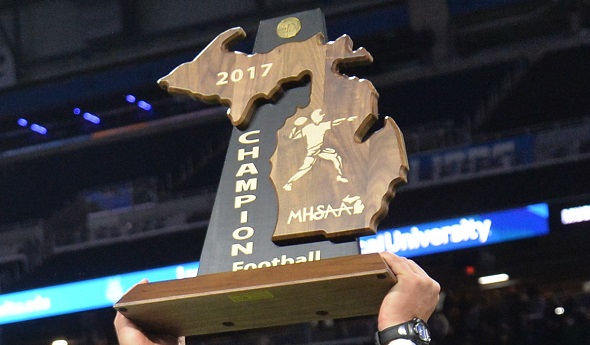
Drive for Detroit: 11-Player Finals Preview
November 20, 2018
By Geoff Kimmerly
Second Half editor
A very recognizable 27 football programs have combined to win the 56 MHSAA 11-Player championships contested so far this decade.
 Perhaps that’s the best way to illustrate the anticipation surrounding this weekend’s Finals, kicking off Friday morning and concluding Saturday evening at Ford Field.
Perhaps that’s the best way to illustrate the anticipation surrounding this weekend’s Finals, kicking off Friday morning and concluding Saturday evening at Ford Field.
Back will be reigning champions Clarkston in Division 1, Warren DeLaSalle in Division 2, Muskegon in Division 3 and Jackson Lumen Christi in Division 6. But we are guaranteed two first-time champions, and could finish with up to five.
Joining the final weekend march for the first time will be Hudsonville Unity Christian in Division 5, and both Division 8 finalists Breckenridge and Reading. Edwardsburg played at Ford Field last season for the first time, but will return seeking its first MHSAA title in this sport – as will other past runners-up Muskegon Mona Shores, Chelsea and Madison Heights Madison.
Clinton Township Chippewa Valley, Montague and New Lothrop are past champions but returning to the Finals for the first time in a decade or longer. Detroit Martin Luther King and Portland are only a few seasons removed from their last trips to Ford Field and back hoping to add to their title legacies.
See below for a look at all of the finalists taking the field, powered by MI Student Aid. Tickets cost $10 and are good for all four games on one day; only cash will be accepted at the door. Click for a full schedule. Also, for the first time, Ford Field will host a pair of Special Olympics Unified flag football games prior to the start of Saturday’s four 11-Player Finals. Teams from Brighton, Holt, Mason and Sparta will take the field at 9:40 and play 20-minute exhibitions. Unified Sports programs combine students with and without intellectual disabilities on competitive athletic teams.
The first two Friday and Saturday Finals will be broadcast live on FOX Sports Detroit’s primary and PLUS channels (check cable/satellite box listings for your specific channel) with the third and fourth games both days available live on FOX Sports Detroit PLUS only. All eight games also can be viewed live on FOXSportsDetroit.com and on the FOX Sports app. Games will be archived for on-demand viewing on MHSAA.tv, which also will live stream the first three postgame press conferences each day. Audio broadcasts will be available on the MHSAA Network website live both days.
Rankings below were voted on by The Associated Press’ media panel – teams that were ranked in different divisions for the regular season are noted. Statistics are current.
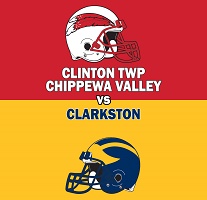 Division 1
Division 1
CLINTON TOWNSHIP CHIPPEWA VALLEY
Record: 13-0, No. 2
Coach: Scott Merchant, 10th season (68-38)
League finish: First in Macomb Area Conference Red
Championship history: Division 2 champion 2001.
Best wins: 28-16 over No. 3 Belleville in Semifinal, 42-7 over No. 6 Dearborn Fordson in Regional Final, 51-10 (District Final) and 24-17 over honorable mention Macomb Dakota, 31-26 over No. 5 Saline.
Players to watch: WR/DB David Ellis, 6-0/195 sr. (630 yards/9 TDs receiving, 3 TDs kick return, 1 TD punt return); RB/DB Andre Chenault, 5-7/195 sr. (1,030 yards/14 TDs rushing); QB Tommy Schuster, 6-0/185 sr. (1,653 yards/24 TDs passing); TE/LB Marcel Lewis, 6-1/220 sr. (4 TDs receiving).
Outlook: Chippewa Valley has been building toward this, with a 10-win season and District title a year ago followed by this fall’s perfect run through one of the most competitive leagues in the state. Lewis – committed to Michigan State – was an all-state linebacker last season and leads a defense that held powerful Belleville last week to its fewest points in two years. Schuster was an honorable mention all-state quarterback in 2017 and has led the offense to a program-record 515 points, spreading the ball to a number of playmakers. Ellis will sign with Indiana University and running back/defensive back Ja’Von Kimpson (11 rushing touchdowns) is committed to Miami (Ohio).
CLARKSTON
Record: 11-2, No. 8
Coach: Kurt Richardson, 32nd season (254-88)
League finish: First in Oakland Activities Association Red
Championship history: Three MHSAA titles (most recent 2017).
Best wins: 21-3 over No. 5 Saline in Semifinal, 13-0 over No. 7 Lapeer in Regional Final, 28-25 over No. 10 West Bloomfield.
Players to watch: QB Jake Jensen, 6-3/180 sr. (1,101 yards/9 TDs passing, 371 yards/9 TDs rushing); RB/LB Jacob Honstetter, 5-11/190 sr. (770 yards/10 TDs rushing; 67 tackles); WR/LB Max Nicklin, 6-2/190 sr. (92 tackles); OL/DL Rocco Spindler, 6-5/270 soph. (82 tackles).
Outlook: The Wolves are seeking their fourth Division 1 championship in seven years, bolstered by a defense giving up 11 points per game – and only four per game during the playoffs. Senior linebacker Brendan Baker and senior defensive backs Keagan King and Josh Luther are among other playmakers leading a veteran group on that side of the ball. Spindler, just a sophomore, is considered among the state’s best in his class (and is the son of former Detroit Lions lineman Marc Spindler). The offense doesn’t have anyone with extraordinary numbers but does its part. Senior running back Jake Billette is the leading rusher with 784 yards, plus five touchdowns on the ground. Clarkston’s two losses, to Oxford and Oak Park, were by a combined 10 points.
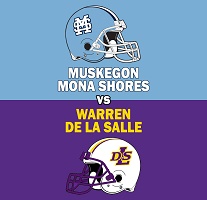 Division 2
Division 2
MUSKEGON MONA SHORES
Record: 12-1, No. 1
Coach: Matt Koziak, eighth season (60-26)
League finish: Second in Ottawa-Kent Conference Black
Championship history: Division 2 runner-up 2014
Best wins: 49-10 (District Final) and 49-42 over Jenison, 48-38 over Division 1 No. 4 East Kentwood, 33-14 over Rockford.
Players to watch: RB/LB Sincer’e Dent, 5-11/217 sr. (1,350 yards, 24 TDs rushing); QB Caden Broersma, 6-3/206 jr. (1,915 yards/19 TDs passing, 1,086 yards/18 TDs rushing); WR/DB James Gilbert, 6-2/179 sr. (1,466 yards/15 TDs receiving); TE/LB Jacob Wahlberg, 6-4/222 sr.
Outlook: Mona Shores has won its last three playoff games all by at least 21 points, and its only loss was to Division 3 finalist Muskegon in Week 8 in one of the Big Reds’ closest games this season. It’s all even more impressive considering the Sailors lost one of the state’s top playmakers in senior receiver Damari Roberson to an injury before the season started. But Gilbert has filled in to an elite degree as the main pass catcher, keeping some attention off Dent, two-way threat Broersma and junior Tre’shawn Hatcher, who has run for more than 700 yards and nine scores. Roberson and Wahlberg both have committed to Western Michigan.
WARREN DELASALLE
Record: 11-2, No. 4
Coach: Mike Giannone, third season (27-9)
League finish: Tied for first in Detroit Catholic League Central
Championship history: Division 2 champions 2014 and 2017, runners-up 2006 and 2008.
Best wins: 35-7 over No. 2 Oak Park in District Final, 21-3 over No. 7 Port Huron Northern in Regional Final, 28-0 over No. 9 Birmingham Groves in Semifinal, 26-10 over honorable mention Warren Mott in Pre-District, 24-6 over Division 1 honorable mention Detroit Catholic Central.
Players to watch: WR/DB Joshua DeBerry, 6-1/175 sr. (701 yards/9 TDs receiving; 43 tackles/5 interceptions); RB/DB Evan Vaillancourt, 5-10/205 sr. (646 yards/14 TDs rushing); RB/LB Jacob Dobbs, 6-1/215, sr. (85 tackles/4 forced fumbles); OL/DL Daniel Motowski, 6-4/270 sr.
Outlook: DeLaSalle is seeking its third championship in five seasons with a group that may not have any individuals who stick out statistically, but just keeps winning. The Pilots gave Muskegon a 15-point game in Week 1 and didn’t lose again until falling to Detroit Catholic Central by three in Week 8 – and they avenged that loss a week later in the Catholic League A-B championship game. DeBerry and Dobbs earned all-state honorable mentions last season; Dobbs is committed to Holy Cross and Motowski to Central Michigan University. Senior quarterback Nolan Schultz has completed an efficient 59 percent of his passes for 719 yards and six touchdowns and run for 10 scores.

Division 3
MUSKEGON
Record: 13-0, No. 1
Coach: Shane Fairfield, ninth season (100-18)
League finish: First in O-K Black
Championship history: Six MHSAA titles (most recent 2017), four runner-up finishes.
Best wins: 45-22 over No. 5 Zeeland East in Semifinal, 34-18 over No. 7 Cedar Springs in Regional Final, 55-35 over Division 2 No. 1 Muskegon Mona Shores, 24-21 over Detroit Martin Luther King (No. 3 Division 2 poll), 36-21 over Division 2 No. 4 Warren DeLaSalle.
Players to watch: RB/DB Jeremiah Lockhart, 5-10/200 sr. (1,157 yards/15 TDs); QB/DB Cameron Martinez, 5-11/190 jr. (2,316 yards/36 TDs, 632 yards/11 TDs passing); RB/LB Ali’vonta Wallace 6-0/230 sr.; OL/DL Anthony Bradford, 6-5/360 sr.
Outlook: If any team in the state has been a favorite from the first day of practice in August, it’s been Muskegon. Martinez has gone from great prospect as an underclassman to arguably the most intriguing standout in the state, while Bradford leads a starting offensive line that averages 6-foot-2 and 305 pounds. The Big Reds got a scare early from King and another in a seven-point Pre-District win over East Grand Rapids, but are the only team with wins over three other finalists playing this weekend. Bradford earned an all-state honorable mention last season and will continue his career at Louisiana State University. Senior back Demario Robinson also has run for more than 700 yards and eight touchdowns this fall; he was averaging 13.5 yards per carry entering the Semifinal as all four of the team’s top rushers were gaining 10 or more yards per carry.
DETROIT MARTIN LUTHER KING
Record: 11-2 (No. 3 in Division 2 poll)
Coach: Tyrone Spencer, third season (34-6)
League finish: First in Detroit Public School League Black
Championship history: Three MHSAA titles (most recent 2016), two runner-up finishes.
Best wins: 34-21 over No. 2 DeWitt in Semifinal, 7-6 over No. 3 River Rouge in Pre-District, 34-14 over No. 9 Warren Woods Tower in District Final, 52-38 over East St. Louis (Ill.).
Players to watch: QB Dequan Finn, 6-1/190 sr. (1,189 yards/20 TDs rushing, 1,936 yards/22 TDs passing); RB Peny Boone 6-1/215 jr. (826 yards/13 TDs rushing); LB Marvin Grant, 6-2/195 sr.; DB Ahmad Gardner, 6-2/160 sr.
Outlook: After winning Division 2 titles in 2015 and 2016, King fell just short of another Finals appearance last fall losing to eventual champion DeLaSalle by a point in a Semifinal. Moving into Division 3 for these playoffs, King navigated a loaded bracket with Finn growing his reputation as one of the state’s most dynamic quarterbacks. Grant – who has committed to Purdue – made the all-state team in Division 2 last season, and Finn earned an honorable mention. Finn will sign with CMU as will receiver Darrell Wyatt, while Gardner is committed to Cincinnati, flanker Jalen McGaughy to Northern Illinois, linebacker Rich Miller to Buffalo, senior safety Ray Williams to Youngstown State and senior offensive tackle DeShawn Ingram to Howard.
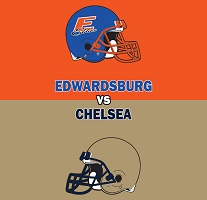 Division 4
Division 4
EDWARDSBURG
Record: 13-0, No. 1
Coach: Kevin Bartz, 24th season (172-74)
League finish: First in Wolverine Conference
Championship history: Division 4 runner-up 2017.
Best wins: 46-44 (OT) over No. 2 Grand Rapids Catholic Central in Semifinal, 38-15 over No. 5 Three Rivers, 56-21 over Holland Christian in Regional Final.
Players to watch: RB/DB Chase Goggins, 5-8/155 sr. (1,355 yards/23 TDs rushing, 344 yards/4 TDs receiving); RB/LB Chase Sager, 6-1/195 sr. (916 yards/17 TDs rushing; 56 tackles/11 tackles for loss); RB/LB Isaiah Mitchell, 5-10/205 sr. (771 yards/15 TDs rushing); QB/DB Tre’ Harvey, 6-1/190 sr. (624 yards/9 TDs passing, 534 yards/7 TDs rushing).
Outlook: Edwardsburg made its first trip to Ford Field last season, and after an 11-point loss to GRCC in the Final came back to avenge that defeat last weekend. A first championship this weekend would top a 58-6 run over the last five seasons where all but two of those defeats have come during the playoffs. Sager was one of the team’s leading rushers in last season’s Final, when Mitchell, Goggins and Harvey all also saw time. Sophomore Drew Bidwell (72 tackles) and senior Dylan McColley (68) team with Sager for a strong linebacker group that’s helped the team give up only 10 points per game.
CHELSEA
Record: 10-3, unranked
Coach: Josh Lucas, first season (10-3)
League finish: Third in Southeastern Conference White
Championship history: Division 3 runner-up 2015.
Best wins: 38-13 over No. 8 Williamston in Semifinal, 21-14 over Farmington Hills Harrison in Regional Final, 35-14 over honorable mention Milan in District Final, 28-21 over No. 3 Grosse Ile in Pre-District.
Players to watch: RB Aaron McDaniels, 5-9/175 sr. (992 yards/17 TDs rushing); WR/DB Hunter Neff, 6-4/210 sr. (1,097 yards/16 TDs receiving); QB Quinn Starkey, 6-3/180 sr. (2,268 yards/25 TDs passing); TE/DE Nick Christian, 6-5/210 sr. (477 yards/4 TDs receiving).
Outlook: Chelsea has made one of the most impressive climbs over the last month after finishing third in its league and then losing at 3-6 Alpena in Week 9. The Bulldogs have cut a touchdown off their defensive points-allowed average during the playoffs, giving up 15.5 over the last four games. The offense has remained steady, meanwhile, even as Chelsea has faced and eliminated two league champions during this postseason. Lucas formerly led the varsity for three seasons at Allegan after five as an assistant at Zeeland East.
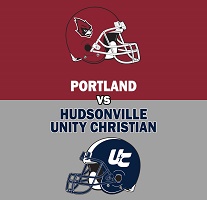 Division 5
Division 5
PORTLAND
Record: 13-0, No. 2
Coach: John Novara, 20th season (145-63)
League finish: First in Capital Area Activities Conference White
Championship history: Division 5 champion 2012.
Best wins: 17-13 (District Final) and 16-8 over No. 5 Lansing Catholic, 40-6 over Frankenmuth in Regional Final, 35-14 over Marine City in Semifinal, 27-20 over No. 9 Montague (moved to Division 6 for playoffs).
Players to watch: RB/DB Jacob Veale, 5-10/165 sr. (1,662 yards/26 TDs rushing); QB/DE Owen Russell, 6-4/195 jr. (559 yards/8 TDs passing); OL/DE Matthew Koster, 6-0/205, sr.; OL/DE Jacob Hickling, 6-3/215 sr.
Outlook: Despite its 2012 championship, Portland remains something of an under-the-radar power statewide. But the Raiders have won at least 10 games four straight seasons and had only four single-digit victories this fall, with the rest by at least 14 points. What’s not a secret is how Portland succeeds – the Raiders went over 3,000 rushing yards for the season last week, and defensively they’re giving up an average of 165 yards and eight points per game. Senior tackle Hunter Klein (6-7, 315 pounds) is among those leading the way for Veale.
HUDSONVILLE UNITY CHRISTIAN
Record: 11-2 (No. 10 in Division 4 poll)
Coach: Craig Tibbe, 16th season (84-79)
League finish: Third in O-K Green
Championship history: Has never played in an MHSAA Final.
Best wins: 14-7 over No. 1 Saginaw Swan Valley in Semifinal, 39-14 over No. 4 Kalamazoo United in Regional Final, 40-37 over No. 6 Muskegon Oakridge in District Final, 41-22 over Grand Rapids West Catholic in Pre-District.
Players to watch: RB/LB Hayden Large, 6-2/185, jr. (1,205 yards/12 TDs); RB/DB Malekhi Obande, 5-8/155, soph. (866 yards/7 TDs); QB/DB Isaac TeSlaa, 6-3/180 jr. (490 yards/11 TDs rushing, 468 yards/3 TDs passing); RB/DL Max Buikema, 5-10/190 sr. (781 yards/13 TDs rushing).
Outlook: Unity Christian will play in its first football championship game to conclude one of the most impressive playoff runs in any division this fall. The Crusaders opened by eliminating five-time reigning champion West Catholic before taking down three ranked teams – last week setting a program record for wins in the process of eliminating last season’s runner-up Swan Valley. And that was after navigating a league that saw four of seven teams make the playoffs, three win District titles and Zeeland East also advance to the Semifinals. Unity has run for 3,942 yards – or 87 percent of its offense this season – and Obande and Buikema have combined for 30 2-point conversions.
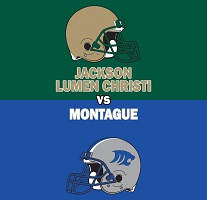 Division 6
Division 6
JACKSON LUMEN CHRISTI
Record: 12-0, No. 1
Coach: Herb Brogan, 39th season (366-83)
League finish: First in Interstate 8 Athletic Conference
Championship history: 10 MHSAA titles (most recent 2017), two runner-up finishes.
Best wins: 42-20 over Montrose in Semifinal, 41-14 over Michigan Center in District Final, 34-12 over Grand Rapids West Catholic, 34-7 over Division 3 honorable mention Parma Western.
Players to watch: RB/LB Nick Thomas, 6-0/205 sr. (1,690 yards/30 TDs rushing); QB Joe Barrett, 6-2/195 sr. (1,180 yards/11 TDs passing); TE/DE Dayton Keller, 6-4/240 sr. (591 yards/2 TDs receiving); OL/DL Keegan Smith 6-3/285 jr.
Outlook: Lumen Christi has yet to have a game closer than 15 points as it marches for a third straight Division 6 title. The Titans have won all four of their playoff games by at least 22 points and are giving up nine per game for the season, with only two of 12 opponents scoring more than 14 (Lumen played 12 games, with an open date Week 9). Senior Cy’Aire Johnson is another exciting player to watch; he starts at defensive back but also is second on the team with nine touchdowns – five receiving and four rushing. Keller earned an all-state honorable mention in 2017.
MONTAGUE
Record: 11-2 (No. 9 in Division 5 poll)
Coach: Pat Collins, 15th season (137-41)
League finish: First in West Michigan Conference
Championship history: Division 6 champion 2009 and 2008, Class CC runner-up 1992.
Best wins: 14-7 over No. 2 Traverse City St. Francis in Semifinal, 30-14 over No. 9 Schoolcraft in Regional Final, 25-24 over Division 5 No. 6 Muskegon Oakridge.
Players to watch: RB/SS Bryce Stark, 5-10/191 sr. (1,579 yards/25 TDs rushing; 61 tackles); QB/SS Drew Collins, 6-2/190 soph. (1,805 yards/16 TDs passing, 417 yards/7 TDs rushing); WR/CB Kenyan Johnston, 5-11/165 sr. (808 yards/8 TDs receiving, 3 TDs rushing; 4 interceptions); OT/DL Luke Marsh, 6-5/290 sr. (77 tackles)
Outlook: Montague made its first Final since the 2009 championship run and has seen its share of tough competition. In addition to the wins above, the Wildcats also took losses to Division 5 finalist Portland and another Division 5 District winner, Reed City. Stark and Marsh made the all-state team last season as juniors, when Montague’s only defeat came in the Regional Final. Two juniors play big defensive roles this time; defensive back Brennan Schwarz leads with 121 tackles plus three interceptions, and linebacker Mark Vanderleest is second on the team with 86 tackles.
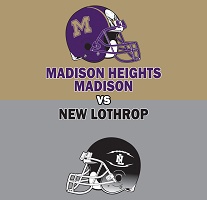 Division 7
Division 7
MADISON HEIGHTS MADISON
Record: 13-0, Tied for No. 3
Coach: James Rogers, third season (31-5)
League finish: First in MAC Silver
Championship history: Division 5 runner-up 2006.
Best wins: 37-34 over No. 7 Cassopolis in Semifinal, 38-0 over No. 10 Detroit Loyola in District Final, 20-7 over Division 4 No. 9 St. Clair, 28-6 over Farmington.
Players to watch: QB/DB Austin Brown, 6-1/190 sr. (2,060 yards/22 TDs passing, 1,831 yards/33 TDs rushing); RB/LB Khyron Franklin, 5-9/185 sr. (1,121 yards/8 TDs rushing); WR/DB Troye Williams, 5-11/185 soph. (689 yards/7 TDs receiving); OL/LB Adam Long, 5-10/190 jr. (181 tackles, 2 forced fumbles)
Outlook: Madison had made its share of playoff runs since it’s last trip to the Finals, missing last year’s championship game with a 14-7 loss to Saugatuck in the Semifinals. They’ve taken the next step with elite play on both sides of the ball, and with most of its regular-season schedule against much larger opponents. The defense is giving up 11 points per game and has an incredible 81 sacks, with seniors Chauncey Earnest (18 sacks), Caelon Eason and Kaylen Jackson (both 14) and junior Aaron McClure (6) bringing the heat up front. Brown has thrown for a combined 4,732 yards and 54 touchdowns and run for a combined 2,225 yards and 41 scores over the last two seasons. He has a big target in 6-4 junior Isaiah Pollard, who has 11 touchdowns on 21 catches.
NEW LOTHROP
Record: 12-1, No. 2
Coach: Clint Galvas, 10th season (105-14)
League finish: First in Mid-Michigan Activities Conference
Championship history: Division 8 champion 2006.
Best wins: 51-22 over Lake City in Semifinal (No. 4 Division 6 poll), 26-14 over No. 1 Pewamo-Westphalia in Regional Final, 51-12 over Montrose.
Players to watch: QB/DB Avery Moore, 6-2/210 jr. (1,533 yards/22 TDs rushing, 1,578 yards/20 TDs passing); RB/LB Will Muron, 5-9/180 soph. (669 yards/10 TDs rushing, 1 TD punt return); WR/DB Aidan Harrison, 6-3/190 sr. (673 yards/14 TDs rushing, 20 TDs receiving, 1 TD kickoff return); OL/DL Garrett Birchmeier, 6-3/250 sr.
Outlook: Perhaps no team statewide has been on the verge of getting back to the Finals more than New Lothrop, which improved last week to 98-10 over the last nine seasons but had three Semifinal losses during that run before downing previously-unbeaten Lake City this time. Moore generates plenty of excitement from his quarterback spot, but Harrison will get plenty of defensive attention – he’s qualified for the record book for single-season touchdowns and will sign with Missouri. The only loss came in Week 9 to Traverse City St. Francis, a Division 6 semifinalist.
 Division 8
Division 8
READING
Record: 13-0, (No. 6 Division 7 poll)
Coach: Rick Bailey, 31st season (209-105)
League finish: First in Big 8 Conference
Championship history: Has never played in an MHSAA Final.
Best wins: 28-6 over Ottawa Lake Whiteford (T-No. 3 Division 7 poll) in District Final, 65-48 over No. 8 Pittsford in Pre-District, 55-7 over Grass Lake.
Players to watch: RB Ethan LoPresto, 5-8/165 sr. (2,422 yards/27 TDs rushing; 57 tackles/15 tackles for loss); QB/DB Alex Price, 6-2/190 sr. (627 yards/10 TDs rushing, 844 yards/9 TDs passing); RB/LB Anthony Willoughby, 5-9/180 sr. (559 yards/13 TDs rushing; 54 tackles); FB/LB Ben Affholter, 6-2/275 jr. (269 yards/4 TDs receiving; 119 tackles/5 forced fumbles).
Outlook: Reading’s season so far has included its first Semifinal run since 2008, a program record for wins and earning a trip to the Finals for the first time ever. LoPresto has led an offense that’s chewed up 5,505 yards on the ground; in addition to those mentioned above, junior Elijah Strine has run for 623 yards and 11 scores. But just as much credit should be paid a defense that earned its seventh shutout of the fall last week against Holton and is giving up 7.2 points per game. Junior Nick Affholter (6-3/302) and senior Caleb Miller both have more than 20 tackles for loss.
BRECKENRIDGE
Record: 13-0, tied for No. 1
Coach: Kris Robinson, sixth season (39-23)
League finish: First in Mid-State Activities Conference
Championship history: Has never played in an MHSAA Final.
Best wins: 12-0 over No. 3 Harbor Beach in Semifinal, 12-6 over Ishpeming (No. 5 Division 7 poll) in Regional Final, 37-12 over No. 4 Johannesburg-Lewiston in District Final, 30-12 over Carson City-Crystal.
Players to watch: RB Hunter Collins, 5-10/185, sr. (1,022 yards/15 TDs rushing, 3 TDs receiving); QB Carter Staley, 6-2/215, sr. (947 yards/13 TDs rushing, 949 yards/10 TDs passing); RB/DB Lukas Ebright, 5-6/160 sr. (300 yards/8 TDs rushing, 460 yards/3 TDs receiving, 1 TD punt return); OG/LB Hunter Smith, 6-2/255 sr.
Outlook: Breckenridge is another that has made an incredible climb; the Huskies were 0-9 just three seasons ago. Robinson has turned the Huskies into a

Culmination of Ideas, Cooperation Lead to Creation of MHSAA Football Playoffs
By
Ron Pesch
MHSAA historian
August 26, 2022
In November of 1972, Dave Driscoll, football coach at Jackson Parkside, was talking by phone with Larry Paladino of The Associated Press about the goals of the recently-formed Michigan High School Football Coaches Association (MHSFCA).
“Football has been around a long time in Michigan, and we just haven’t moved forward as other sports have. Now with an organization to speak and help us, I think we will see some real movement …”
Driscoll, president of the MHSFCA, was pitching the idea of a football postseason in Michigan – a goal of the young organization.
“It took us a couple of years to get it done,” recalled Driscoll, now age 86 and still in the Jackson area. “The first year or two was a challenge because that’s when you’re instituting something. But it has turned out to be a very progressive, positive influence in the state.”
A Postseason
Michigan was one of only 20 states that did not conduct a football playoff, and the sport was the only one sponsored by the MHSAA that did not have a tournament to determine champions. Newspaper ranking systems, in use since the early 1940s in Michigan, were the method by which football teams were awarded “state titles.” Prior to that, schools with undefeated marks against in-state opponents could make a rightful claim to a championship. Because there was no postseason system in place for teams to square off, those are referred to as “mythical” titles.
A state gridiron playoff had been discussed for many years. But, as a cold weather state, few could see a way to devise an equitable system to accomplish the task. With basketball, every high school squad qualified for the annual MHSAA Tournament. Logistically and geographically, the concept of a football postseason presented numerous challenges. Unpredictable late fall weather meant the season could be expanded by only a couple of weeks. That limited the number of teams that could be involved.
 Yet Colorado and Massachusetts, both with weather that could replicate Michigan’s in late autumn, hosted football postseasons.
Yet Colorado and Massachusetts, both with weather that could replicate Michigan’s in late autumn, hosted football postseasons.
“They just extend the season by two weeks,” said Driscoll, the MHSFCA spokesperson at the time. “They divide the state by regions. If you win a region, you have a semifinal game the next week, then a final a week after that in each class.”
The MHSFCA, broken into 18 regions across the Upper and Lower Peninsulas, recognized that was far too many to work within a two-week playoff system. So, determining the teams that would participate in the tournament was a major concern.
“Ohio rates its teams by computer. Pennsylvania has a system for it. … Our association would have to investigate these and come up with the best one for our situation,” Driscoll said.
Only eight months old, the MHSFCA planned to present its research, and a possible approach, to the Michigan High School Athletic Association. Driscoll had spoken to both Allen W. Bush, MHSAA executive director, and Vern Norris, associate director, about the goal.
“They’re listening,” he told the press. “If we can come up with a feasible plan, I think they’re willing to listen. We hope to have playoffs in two or three years.”
So the MHSFCA went to work, scheduling meetings around the state – talking with, and listening to, membership.
“We’re not going to press for any certain system at this time. It will take time to work out the details. We just want to sell the idea,” Driscoll said.
The MHSFCA recognized it could take a while.
“Iowa had to present the playoff five years before it was approved,” noted Driscoll.
While the administrative wheels turned, the MHSFCA worked on developing a point system designed to reward teams based on strength of schedule. The goal was to create a test – ideally during the 1973 season – designed to prove the concept, with the hope for an actual playoff in the fall of 1974.
One thing almost certain to occur, if a system could be developed, would be a recasting of those newspaper rankings.
“Indiana had a dry run on their (proposed) playoffs last year and four of the top five teams in the football polls did not make the playoffs on a point system.”
“No matter how honestly polls are conducted,” stated Jim DeLand of the Benton Harbor Herald-Palladium in April 1973, “they inevitably favor unbeaten teams with an easier schedule over teams with a tougher schedule, and say, one loss.”
Financing the Idea
According to the coaches’ group, most football playoffs in other states had been self-supporting and profitable. “Ohio played its semifinals in a doubleheader at the Ohio State stadium last fall and drew 20-some thousand people,” noted Ike Muhlenkamp, coach at St. Joseph High School and Region 5 director of the MHSFCA, in conversation with DeLand. That additional revenue, he noted, could be used to support other things that were coming along, like girls athletics.
MHSFCA regional directors conducted meetings around the state in April 1973 to explain the proposal.
The idea was to use a point system to determine which teams would qualify for play. A school’s classification – Class A, B, C, or D – determined by enrollment size, would be used here as well. Just like basketball, four schools would emerge as champions at the end of the tournament.
“It’s complicated … complicated,” said Bush about the proposal to institute a football playoff just prior to a May pitch by the coaches to the MHSAA Representative Council. “There’s a tremendous mass of bookkeeping involved. Other states are doing it, and we can’t turn our backs on it, but I don’t anticipate it happening this year.”
The Council was receptive to the idea, but it needed examination and testing. The Council called for the assembly of a “Blue-Ribbon panel” of superintendents, principals, athletic directors and coaches from around the state to determine the potential of a football postseason and to explore and address the challenges. Harley Pierce, Sturgis football coach, was named chairman of the committee.
“We’d like to see it operate on paper first,” Driscoll told Dean Howe of the Flint Journal. “That way, we’d know approximately how the real thing would operate.”
“Right now, the Blue-Ribbon committee is studying three point systems, ones used in Ohio, Virginia, and Iowa,” noted Howe. “In Ohio, ratings are done strictly by computer. It costs $5,000 a season to use the computer system.”
In October, the Council asked that the proposed point system be refined.
A key component, as envisioned by the MHSFCA, was to create a system that factored in the quality of competition played by a team during the regular season.
“A team with an 8-1 record might be picked over a 9-0 club by season’s end if that team had played much better competition,” explained Howe.
A special questionnaire was distributed by the MHSAA in February 1974. “By almost a 5 to 1 margin, prep coaches throughout the state supported the playoff,” stated Bob Gross in the Lansing State Journal.
 Under the refined system, football game results would be gathered and run through a formula that awarded points based on wins and ties constructed around enrollment classifications, and bonus points for the results of games played by your opponents. League affiliation and margin of victory held no bearing on playoff points awarded.
Under the refined system, football game results would be gathered and run through a formula that awarded points based on wins and ties constructed around enrollment classifications, and bonus points for the results of games played by your opponents. League affiliation and margin of victory held no bearing on playoff points awarded.
In May, the Representative Council, acting on the strong support by coaches for a football tournament, instructed staff at the MHSAA to conduct a sample playoff, on paper, during the 1974 season. The approach would serve as a testing ground – a place to run the idea around the track with live data.
The reality of an actual postseason was still, at minimum, a year away. If all worked as intended, the hope was for an actual tournament in 1975 and 1976, with a re-evaluation of the system to follow. But obstacles remained.
“Weather, playing conditions, sites, records of teams and you name it, we’re faced with just about everything when it comes to something like this,” said Bush. “Teams in the U.P. start the regular season two weeks early so naturally they’re finished by the time teams in the Lower Peninsula are in their sixth and seventh games.” If a U.P. team qualified for the proposed tournament, “they’d have to wait two weeks at least to prepare for a playoff.”
In the end, the idea would still need approval by the Association of Secondary School Principals, which had the “final word on all athletic policies.”
“The coaches are on one side of the fence and administrators (on) the other,” Bush continued. “(T)here’s still a lot of work to do before we actually have a playoff.”
Paper and Pencil
University of Michigan’s Bo Schembechler endorsed the idea and stated in a letter to the MHSFCA that he’d like to see the title game played at U-M. Within, he addressed a concern expressed in some administrative circles. At the time, 652 schools in Michigan played football.
“The fact is that only 16 schools will have an extended season,” stated Schembechler. “There should be little, if any, effect on the basic philosophy of scholastic emphasis.”
Michigan State football coach Denny Stolz also wrote a letter to the group stating he, too, favored the playoff system.
Labeled the “Paper Playoffs,” the proof of concept was handled in the old-fashioned manner, as according to Bush, a computer would not be used for point calculations. It would cost too much.
Instead, at schools that believed they deserved consideration, athletic directors were to fill out a rating form after the season’s sixth game with appropriate information about the results of games played. School principals were to sign the form and mail it to the MHSAA. A single MHSAA staff member each week would then manually “tabulate the results and determine the top teams in each class of four regions” and release them for publication.
The resulting rank of teams was expected to be controversial by both the MHSAA and the MHSFCA. Smaller schools beating teams above their enrollment classification would benefit from the system. Larger schools facing smaller schools would receive fewer points for a win than they would by defeating a team within their own classification. As predicted, an undefeated season was no guarantee of a place within the 16-team field of qualifiers.
“After the formula was devised, the coaches applied it to the top teams in the 1973 Class A poll,” stated Dave Matthews in a State Journal article that appeared just prior to the start of the 1974 season. Saginaw Arthur Hill – undefeated, untied, and unscored upon across nine games – had been named state champion in every state newspaper poll. The Lumberjacks had outscored their opponents, 443-0, but would have finished third in their region in the playoff rankings behind both Flint Southwestern (8-1) and East Lansing (9-0). Simply put, Arthur Hill would not have qualified for the playoffs. Based on the formula, both Southwestern and East Lansing had played more challenging schedules than Arthur Hill.
Controversy
Results needed for the first tabulation following the Week 6 games were slow in arriving. As of the Tuesday following the game, the MHSAA had received only 60 forms. With Wednesday as the cutoff date, the first round of calculations didn’t include teams – like undefeated South Haven – that appeared in the weekly newspaper polls. (South Haven’s form didn’t arrive until after the deadline). That illustrated the need for timely reporting.
Comparisons between the press polls and the “paper playoff” rankings were common, and by season’s end, they illustrated the seismic shift that was approaching – and a call for action.
“Football games aren’t won or lost on paper. Neither are state championships,” wrote Roger Neumann in the State Journal in early November as the season headed for its conclusion. “That’s why most mid-Michigan prep coaches are anxious to see the state’s experimental ‘paper playoffs’ taken a step further and put on the gridiron.”
While it appeared a large majority of coaches – and school administrators – favored moving forward, support for the proposed system certainly wasn’t unanimous.
East Lansing coach Jeff Smith questioned the approach.
‘I’m still for a playoff,’ Smith told Neumann. ‘‘But I have some reservations. I’m not sure that the No. 1 team in each region is the best team.” While Smith admitted he didn’t have an answer on how to improve upon the suggested point system in place, he offered a suggestion.
“If we’re going to do this, I think we should do it right and have eight teams in the playoffs (per classification). Eight teams would be more representative. You’d still be going with the elite of the state.”
Smith noted an expanded playoff with three rounds could still be accomplished within two weeks as the MHSAA allowed teams to play every five days.
“With or without such a change, however, Smith said he’d vote for a true playoff, adding, ‘Any playoff is better than no playoff at all. Once you’ve got it, you can always make changes later,” reported Neumann.
The final AP polls, released Tuesday, Nov. 12, showed Birmingham Brother Rice, Muskegon Catholic Central, Hudson, and Traverse City St. Francis as respective state champions in Classes A, B, C, and D, respectively. United Press International (UPI) differed in only Class C, with Battle Creek St. Philip as the top-ranked team, just five points ahead of Hudson.
According to the final “paper playoff” rankings, only Muskegon Catholic and St. Philip would have qualified for postseason play.
Approved
“It’ll be the principals who’ll really decide if there’ll be playoffs,” said Dick Comar, publicity director for the MHSFCA in late January of 1975. The principals were to receive a questionnaire within a week asking their opinion on the proposal. They had until Feb. 24 to cast their vote.
The results of the survey would be presented to the MHSAA Representative Council at its March 21 meeting in Ann Arbor (coinciding with the annual basketball championships at U-M’s Crisler Arena), with a final decision concerning the issue “at that meeting or at their meeting in May.”
On March 22, Bush announced the proposal had passed, indicating that 73 percent of high schools that had responded to the survey had voted in favor of postseason play. Michigan would have a football tournament. Sites and dates were to be determined. The Council requested that semifinal games be played on high school fields, and that, if possible, the final-round contests be played on artificial turf.
By May, the MHSAA had contracted ESR Corporation, a data processing firm in Lansing, to handle the input of weekly game results. Using the same formula developed and tested, ESR would be responsible for calculating point totals to determine the state’s best teams by Class and region.
Norris called the plan “a combination of the best features already in use in Ohio, Iowa, and West Virginia.” He credited former Alpena coach Art Gillespie with doing much of the work for “carrying the ball through the preparation stages.”
Five members of the media – Howe of the Flint Journal, Jack Moss of the Kalamazoo Gazette, Joe Walker of the Saginaw News, Ed Senyczko of the State Journal, and John Carlisle of the Sault Ste. Marie Evening News – were tasked with capturing the results of games played by 679 schools, including 28 from outside of Michigan, and mailing the results to the MHSAA.
“We’re not interested in the score,” said Bush. “We want to know if a team won, lost, tied, or did not play.”
 In August, the MHSAA announced that state title games would be played at two sites on Saturday, Nov. 22. Western Michigan University would host the Class A and D games, while Class B and C were slated for Central Michigan University.
In August, the MHSAA announced that state title games would be played at two sites on Saturday, Nov. 22. Western Michigan University would host the Class A and D games, while Class B and C were slated for Central Michigan University.
The four regions used to divide up the state for the annual basketball tournament also were used as the regions for football.
In September, with the results of the season’s first games – played by the state’s Upper Peninsula teams – fed into ESR’s computers, Bush was clear that the final playoff rankings would cause controversy.
“It’s not necessarily the four best teams in the state that will compete in the semifinals,” he said, “but the best in each region.”
The result was both popular and controversial. The papers continued their weekly football polls. The first MHSAA rankings were not released until Oct 8.
UPI was unimpressed: “If the playoffs were held this weekend – which they are not – not a single one of the teams UPI has rated first in the four classes would qualify.”
Hal Schram of the Detroit Free Press expressed a similar emotion.
“The first computerized points were announced last week and there were glaring differences between the media polls and the MHSAA system,” he wrote.
“’There is no reason to attempt a state football championship, and extend the season two more weeks, when you’re inviting only four teams in each class to perform,’ said Joe Vanderhof, veteran sportswriter of the Grand Rapids Press.
Skepticism continued as the weeks went on, culminating in joy for 16 schools – but disappointment for many others – when the final MHSAA rankings were released Nov. 9.
Norway, undefeated in nine games, was the first to experience heartbreak, as U.P. teams finished their season earlier than others. Tied with Ishpeming in the Region 4 Class C rankings, the Knights lost the playoff spot by a tie-breaking formula. Since the two schools had not played each other, a second method was employed to break the deadlock. The summed win-loss percentage of each school’s opponents was compared, with Ishpeming coming out two-tenths of a percent higher. Two of Norway’s top challengers had not played a ninth game. If either had at least tied another contest, Norway would have slipped ahead in the rankings.
“We’ve been ranked … in the AP ahead of Ishpeming all year,” stated Knights coach Bob Giannunzio. “This is hard to swallow.”
Jim Crowley, coach of Jackson Lumen Christi, was also among the disappointed: “You do everything you can and still don’t make it. Undefeated, the team finished No. 1 in Class B according to UPI.”
“But had it not been Lumen Christi,” noted UPI writer Richard Shook, “then it would have been Dearborn Divine Child (missing out). They were both in the same playoff region.”
Trenton in Class A, Divine Child in Class B, Hudson in Class C and North Adams in Class D finished on top in the final AP poll. Only Trenton did not qualify for the postseason. Traverse City topped Trenton in the final UPI and Free Press polls and did qualify. Lumen Christi finished No. 1 in Class B, Hudson in Class C, and Crystal Falls Forest Park – another qualifier – finished on top in Class D in the Free Press.
“I’ve got the best football team in the state,” Trenton coach Jack Castignola told Schram. “I’ve got at least two future Big Ten players. We had three goals at the opening of practice in August, to go unbeaten, win the conference and the state. We’ve been deprived of reaching our final goal and there’s nothing we can do about it. Corrections are going to have to be made in future years.”
Flint Ainsworth, with a 7-2-0 record, ranked 14th in the UPI poll, was the only team unranked and without even honorable mention in the AP poll to qualify for the tournament.
Livonia Franklin, Divine Child, Ishpeming, and Forest Park emerged as the MHSAA’s first gridiron champions. Since that time, various alterations have been made to the football playoffs. Seasons now begin sooner, many more teams qualify for the postseason, and, beginning in 1976, championship games were moved indoors. Today, 10 teams – eight 11-player squads and two 8-player teams – will be awarded titles come November.
But it was the efforts and collaboration of many that got us here.
“There were a lot of great people involved,” said Driscoll, reflecting on those efforts some 50 years later, and emphasizing that he was only one of many individuals on the same team, uniting behind a goal. “We got great cooperation. We had some super coaches and … some administrators that were not afraid to step forward and say, ‘Hey! These are good people and I know if they do it, they’ll do it the right way.’”
 Ron Pesch has taken an active role in researching the history of MHSAA events since 1985 and began writing for MHSAA Finals programs in 1986, adding additional features and "flashbacks" in 1992. He inherited the title of MHSAA historian from the late Dick Kishpaugh following the 1993-94 school year, and resides in Muskegon. Contact him at [email protected] with ideas for historical articles.
Ron Pesch has taken an active role in researching the history of MHSAA events since 1985 and began writing for MHSAA Finals programs in 1986, adding additional features and "flashbacks" in 1992. He inherited the title of MHSAA historian from the late Dick Kishpaugh following the 1993-94 school year, and resides in Muskegon. Contact him at [email protected] with ideas for historical articles.
PHOTOS (Top) The MHSAA program greets fans for the first Football Finals. (2) Jackson Parkside coach Dave Driscoll talks with one of his players in 1971. (3) A points system was created to determine the field for the first MHSAA Football Playoffs in 1975. (4) Media members were responsible for collecting scores for the MHSAA to tabulate playoff rankings. (Photos gathered by Ron Pesch.)

